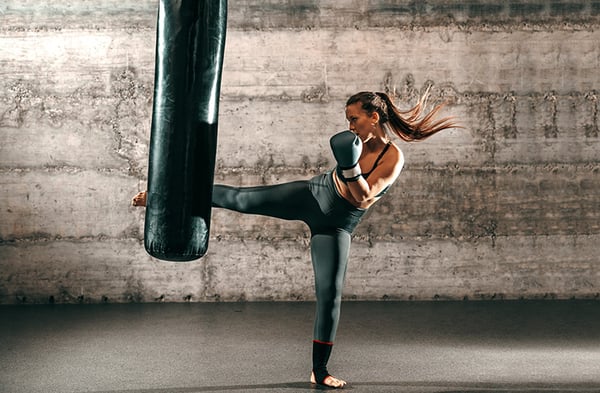What Is Cardio Kickboxing?
Cardio Kickboxing is a martial art inspired group fitness format that is both heart-pumping and exhilarating. Using punches and kicks from disciplines such as karate, Muay Thai, and traditional boxing, group fitness participants worldwide have fallen in love with this class format. Cardio Kickboxing is a total body workout that involves utilizing multiple muscle groups to elevate the heart rate and train participants in speed, agility, and quickness.
In most Cardio Kickboxing classes in the movement prep segment, participants will be introduced to the proper technique in executing the four main punches: jabs, crosses, hooks, and uppercuts. In addition to punches, cardio kickboxing participants will also learn how to safely perform the kicks used during class. Front, side, back, and roundhouse kicks are the commonly used kicks in cardio kickboxing and will get your heart rate elevated.
You may find that some Cardio Kickboxing classes will also involve contact. These classes will integrate equipment such as boxing gloves, pads, jump ropes, and even heavy bags to enhance the in-class experience. Participants may work in pairs, simulating boxing rounds, or work on individual heavy bags performing punching and kicking drills. Incorporating these additional tools will create a kickboxing atmosphere that will psychologically engage participants and, in some instances, increase the intensity of the workout.
Cardio Kickboxing is another group fitness format that has branched off into “boutique” fitness centers where focusing on a consistent member experience is the priority. Complete with standardized programming and the use of heart rate monitors, these facilities have been popping up all across the country.
See the AFAA Cardio Kickboxing Training Course if you want to teach some classes!
Cardio Kickboxing Workout for Beginners
A beginning Cardio Kickboxing workout should take the participant through safely executing the stance, punches, and kicks used during the body of the workout. The stance can face forward (horse stance) or slightly to the side with one foot (fighter stance). In either of the two stances, foot placement should be at least hip with apart with the knees slightly bent to provide a stable base. Core muscles should be braced (isometrically contracted), shoulders are somewhat rounded forward (protracted), elbows bent and close to the torso with fists about chin level.
Jabs and Cross punches should be executed with approximately 90-95% extension of the elbow. The target should be the head or upper body. Depending on the stance, the upper body may rotate with the punching arm. Hooks are circular punches executed with the elbow at a 90-degree angle and the forearm parallel to the floor. The power from a hook comes from the torso's rotation, hip, and knee while elevating the heel. Just like the jab, the point of contact would be the head or upper body. Executing an uppercut punch is with the elbow at a 90-degree angle, but unlike the hook, the point of contact for this upward punch should be the rib cage or under the chin.
All four kicks performed in a cardio kickboxing class should include four phases: chamber, strike, re-chamber, and return. These four kicking phases ensure kicks you are executing them in the safest way possible. The chamber pulls the leg toward the core with the knee flexed. The strike extends the leg in the kick's direction (front, side, or back). Re-chambering the leg quickly returns it to the chamber position and prevents injuring the knee. Lastly, the return brings the foot back into contact with the floor. It is important to remember that the core musculature is the foundation for performing all kicks successfully. Participants should avoid performing any kicks at a height that forces the core out of proper alignment.
Sample Beginner Cardio Kickboxing class
RHFS – Right-Hand Fighting Stance
LHFS – Left-Hand Fighting Stance
HS – Horse Stance
MOVEMENT PREP (Warm-Up)
RHFS:
Jab x 8
Cross x 8
Jab/Cross (1/2 tempo) x 8
Hook x 8
Uppercut x 8
Hook/Uppercut x 8
Jumping Jacks (transition to LHFS and repeat)
Knee strike/March three x 8
Front Kick (low)/March three x 8
DBL Step touch/sidekick (alternating sides) x 8
Back kick/March three x 8
BODY OF WORKOUT
Block A
HS:
4 Jabs R moving R/4 Jabs L moving L x 8
4 Jabs R/L/R/L (tempo)/2 Uppercut (slow) x 8
Hook (slow) x 8
8 Alt Jabs (tempo)/4 uppercut (tempo)/2 hooks (slow) X 8
Block B (8ct combo)
RHFS:
Jab/Cross/Hook (4) Boxer’s shuffle (4) X 4
Change Boxer’s shuffle to front knee/back knee X 4
Change back knee to back kick x 8
Jump rope (transition to LLFS)
Block C (16ct combo)
LHFS:
Hook R/L (4) Boxer’s shuffle (4) x 4
Change Boxer’s shuffle to step L, right knee
Change Knee to front kick
Jumping Jacks (transition to LLFS)
TRANSITION
Once you complete the body of the workout, participants should perform post exercise movements that gradually return the body to its pre-exercise levels. I recommend you perform static stretches of all major muscle groups used in the Cardio Kickboxing class also at this time. Holding static stretches for the upper back muscles, pectorals, hips, quadriceps, hamstrings, and gastrocnemius (calves) should be done for a minimum of 30 seconds.
Overall, Cardio Kickboxing is an excellent way to implement cross-training to an individual’s fitness program. It allows participants to get a great cardio workout still. Because cardio kickboxing is low impact, it also reduces the amount of joint stress caused by other high-impact exercise formats.
References
Aerobics and Fitness Association of America. 2010. Fitness: Theory and Practice (5th ed.). Sherman Oaks, California: AFAA.
Athletics and Fitness Association of America. 2019. Principles of Group Fitness Instruction (2nd ed.). Burlington, MA: Jones and Bartlett Learning.


